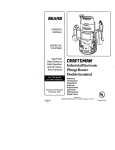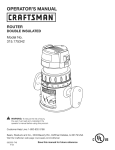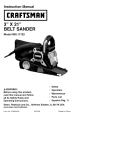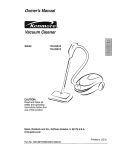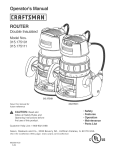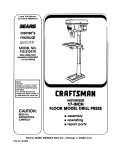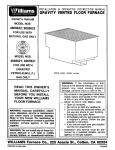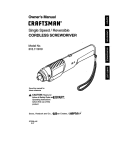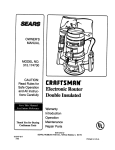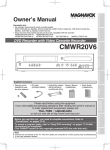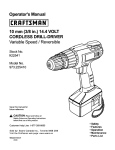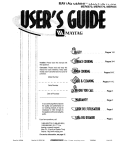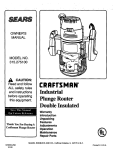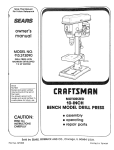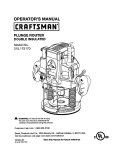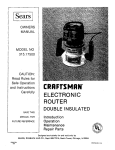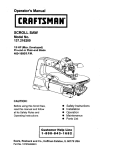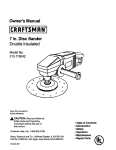Download Craftsman 315.275062 Owner`s manual
Transcript
OWNER'S
MANUAL
MODEL NO.
315.275062
CAUTION:
Read Rules for
Safe Operation
and All Instruc-
CRRFTSMRN
Industrial Electronic
Plunge Router
Double Insulated
tions Carefully
Thank You for Buying
Craftsman Tools
Warranty
Introduction
Unpacking
Features
Adjustments
Operation
Maintenance
Repair Parts
Designed exclusively lot and sold only by
SEARS, ROEBUCK AND (30, Ho[fman Estates, IL 60t 79
Prlnled in U,S,A
6-95
It thisCraftsmanIndustrialElectronicPlungeRouterfails due to a defectin matedal orworkmanshipwithinoneyear
fromthe dateof purchase,Sears willrepairit free of charge, Thiswarrantyapplies onlywhilethis productis in use
in the United States. WARRANTY SERVICE IS AVAILABLE BY SIMPLY RETURNING THE TOOL TO THE
NEAREST SEARS STORE OR SERVICE CENTER THROUGHOUTTHE LINrrED STATES.
This warrantygives you specifto legal rights, and yDumay also haveother rights whichvary from stateto state.
SITARS; ROEBUCKAND CO
DEPT. 817 WA
HOFFMAN ESTATES, IL 60179
........................................................
L
iNTRODUCTiON
DOUBLE INSULATION is a concept in safety, in electrlo
powertools,whicheliminates lhe need for the usual three
wire groundedpower cord and grounded supply system.
Whereverthere is electric currantin the toolthere are two
completesets of insulationto protectthe user, /kit exposed
metal partsare isolatedfrom internalmetal motor componentswith protectingInsulation,
RULES
IMPORTANT - Servicing of a tool with double Insulation
requiresexl_ome care end knowledgeof the systemand
shouldbe pedormedonly by a qualifiedservice technician,
For_ervfcewe suggestyoureturn the tool to your nearest
SearsStoreforrepair, Always use original factoryreplace.
ment pads whenservicing,
FOR SAFE OPERATION
READ ALL INSTRUCTIONS
1.,
KNOW YOUR POWFJRTOOL - Read owner'smanual carefully Learnitsapplicationsandlimitationsas weli asthe
specific potentialhazards related tothistool..
2,
GUARD AGAINST ELECTRICAL,SHOCK BY PREVENTING BODY CONTACT WITH GROUNDED SURFACES.
For example: Pipes,radiators,ranges,refrigeratorenclosures
3o
4,
KEEP GUARDS tN PLACE and in workingorder,
KEEP WORK AREA CLEAN. Clutteredareas and benchesinviteaccidents,
5.
/WOLDDANGEROUS ENVIRONMENT, Don'tuse powertoolin damp or wetlocationsor expose torain. Keepwork
area waitiIL
6
KEEP CHILDREN AND VISITORS AWAY. Allvisitorsshould wear safety glassesand be kept a safe _istance
from work area,, Do not I_t visitorscontact too! or extensioncord
7
STORE IDLE TOOLS. When not in use tools should be storedIna dry, highor locked-upplace- outof lhe reachof
children
8.,
9.
DON'T FORCE TOOL. It wilt do the job better and safer st the rate for whichit was designed.
USE RIGHT TOOL, Don't force small toot or attachment todo the job of a heavy duty tool Don't use toot for purpose
notintended - for example - Don't use a circularsaw forcuttingtree limbs or togs.
10.
WEAR PROPER APPAREL. No loose clothingor jewelrytoget caughtin movingparts_ Rubbergrovesand nonskidfootwear ate recommended whenworkingoutdoors Also, wear protecSvehaircoveringto containlonghairand
keep Itfrom being drawn into air vents
t!,
ALWAYS WEAR SAFETY GLASSES. Everyday eyeglasseshave only tmpact-reslstant lenses; they are NOT
safetyglasses,
12
PROTECT YOUR LUNGS, Wear a face or dustmask tfoperation is dusty
13.
PROTECT YOUR HEARING. Wear hearing protection dudngextendedperiodso!operation
!4..
DON'T ABUSE CORD. Never carrytoo_by cordor yank itto disconnect from_eceptac_e Keep cordfromheat, eli
and sharpedges.
Page 2
RULES
15.
FOR SAFE OPERATION
(Continued)
SECURE WORK. Use ctampsor a vise tohold work Bolh hands are needed to operate the tool
16_ DON'T OVERREACH, Keep properfooting and balance at alltimes Do not use on a ladderor unstablesupport
17.
MAINTAIN TOOLS WITH CARE Keep tools sharpat afltimes, and cleanfor bestand safestperformance. Follow
instruclionsfor lubricating and changingaccessodes_
18.
DISCONNECT TOOLS, When not in use, before servicing, or whenchangingaltachments, blades, bits, cutters,
etc., all tools should be disconnectedf.rampowersupply.
19.. REMOVE ADJUSTING KEYS AND WRENCHES, Formhabitofchec.kingtoseethatkeysandadjuslingwrenches
are removed from toolbefore turningit on..
20., AVOID ACCIDENTAL STARTING. Don't carry plugged-in tools with finger on switch Be sure switchisoff when
pluggingin.,
21. MAKE SURE YOUR EXTENSION CORD IS IN GOOD CONDITION. When using an extension cord,be sureto use
one heavy enoughto carry the currentyour produclwittdraw.An undersized cordwillcause a drop tn linevoltage
resulting in loss of power and ove_eattng. A wlre gauge size (A.W.G) of at least 14 is recommendedfor an
extensioncord 25 feet or less In length.,A cord exceeding25 feet is not recommended, i1in doubt, use lh next
heaviergage. The smallerthe gage number, the heavierthe cord
22.
OUTDOOR USE EXTENSION CORDS, When tootis used outdoors,use only extensioncords suitable for use
outdoors, Outdoor approvedcordsare marked withthe suilixW,.A,for example - SJTW-A or SJOW_A.
23.
KEEP CUTTERS CLEAN AND SHARP. Shaq_cuttersminimizeslallingandkickback.
24.
KEEP HANDS AWAY PROM CUTTING AREA. Keep handsaway from cutlers. Do not reach underneathwork
while cutteris rotating. Do not attempt toremovematerialwhilecutteris rotating
25
NEVER USE IN AN EXPLOSWE ATMOSPHERE. Normalsparkingel the motor couldignite fumes.,
26
INSPECT TOOL CORDS PERIOOICALLY and if damaged, have repaired at your nearest Sears Repair Center
Stay constantlyaware el cordlocation.
27,. INSPECT EXTENSION CORDS PERIODICALLY andreplacetfdamaged.
28
KEEP HANDLES DRY, CLEAN, AND FREE FROM OIL AND GREASE, Always use a cleanclolhwhencleaning.
Never use brake fluids,gasoline, petroleum.based produclsor any strong solventsto cleanyour tool,
29
STAYALERT.
rush.
30
CHECK DAMAGED PARTS. Before ludheruse of the tool,a guardor otherpart thatis damaged should be carefully
checked todetermine that ttwilloperate properlyand performitsintendedfunction,.Check for alignment of moving
parts, blndtng of moving parts, breakage of parts, mounting, and any otherconditionsthai may affeclits operation., A
guard or other part that ts damaged should be propedy repaired or replaced by an authorized service center unless
Indicated elsewherein thtsinstruction manual
31.
DO NOT USE TOOL IF SWITCH DOES NOT TURN IT ON AND OFF. Have defective switches replaced by an
authorizedservicecenter
32
33
Inspectfor and removeall nailsfrom tumber before muting..
DRUGS, ALCOHOL, MEDICATION. Do not operate tool while under the influence oFdrugs, alcohol, or any
medication
34.
WHEN SERVICING USE ONLY IDENTICAL CRAFTSMAN REPLACEMENT PARTS.
35
POLARIZED PLUGS, To reduce the rfskofelectricshock,thistoolhasa polarizedplug(one blade iswiderthan the
other), This plugwtl!fit in a polarized outlet only one way. If the plugdoes not fit fully in the outlet, reverse theplug.
if it stltldoes notfit,contacta qualifiedelectricianto install the proper outteL Do not change lhe plugin any way.
DO NOT USE TOOL UNDER "BROWN-OUT" OR OTHER LOW VOLTAGE CONDITIONS, Also. do notuse with
any devicethat could cause lhe power supply voltageto change,,
WHEN USING THIS ROUTER WITH A ROUTER TABLE, HELP PREVENT POSSIBLE SERIOUS INJURY BY
KEEPING THE Cbq'TER GUARDED AT ALL TIMES. Useonlyrouter tables,wlih guards,thathave beendesigned
for use on reuters thai are of thistype, size, and weigh!
36.
37.
38
Watchwhat you are doing anduse commonsense. Donor operate tool when you are tired, Donot
SAVE THESE INSTRUCTIONS. Review them frequently and use them to Instructotherswho may use Ibis tool If
youloan someone thistool, loan them theseinstructions also.
Page 3
UNPACKING
Yournew plungerouter comesfullyassembled. After removing it fromthe box.inspecti_carefuflyto makesure that it Is
not damagedend that no partsare missing, See Figure Io The followingaocesso_es should also be includedin the box"
1o CombinationWrench(3/8 In - 718In.,)
2, 1t4In. Adapter
3. EdgeGuide
4., Roller(Contour)Guide
5 GufdeBushing
FEATURES
Your electronicrouter is a versatile woodworkingtoo! which witl give you years of trouble-free performance. It is
engineeredwith the professionaltn mind, butits ease of operationsnows the amateurto produceworkwhichis beautiful
and precise,,
LARGE HANDLES
3.5 HORSEPOWER
MOTOR
Your routar has a powerful3°5 horsepowermotor wilh
sufficientpower to handle the toughestroutingjobs. The
motor also has externallyaccessiblebnJshesfor ease of
servicing,,
SOFT START
The soft start featurebuildsmotor RPM graduallyto minf_
mize sled.up torque Pressing or releasing the "on-aft"
tdggert_l{ rum your reufer on or off_
DEPTH CONTROL KNOB
A large depth control knob makes precise depth of cul
changes possible, it also is very hefpfutwhen making
depth o! cut changes with your router mounted upside
down on_t routertable.
DEPTH STOP SYSTEM
The depth stop block !ocaled on the base of your router
provides three adjustable stops and throe fixed stopsfor
quick depth of cut changes, A depth adiustment scale
makes quick adjustmentsto depth of cut changes possible. The spring loaded adjustmentknob quick releases
stop bar by depressingcenterof knob,
1/4 IN. AND !/2 IN. SHANK CAPACITY
Your router has a 1t2 in, ctlameter coital that accepts
cutterswith !/2 in. shanks. An adapter has been provided
So that cutterswith 1t4 ln.shank bitscan also be used.
CHIP SHIELD
A clear plasticsee-through chip shield has been provided
on the baseof yourrouter for protectionagainst flyingdual
and chips,, It is designed to fit the front openingof the
routerbase.,
POStLOCK SPINDLE LOCK
A positockaplndie lock securesthe spindle so that only
one wrench is needed to loosen cotternul and change
cutters. A spindle lock indicator light alerts you that
spines is looked if you connect router to power supply
beforeunlockingspindle, NOTE: Yourrouterwillnotrun if
spindleis locked.,
"LOCK-ON" FEATURE"
Your router Is equipped with a 'lock-on" feature that is
convenientwhencontinousoperation forextendedperiods
of time is required
Your router has large oversized handlesfor easyhandling
and maintaining proper control when routing The left
handle allows you to set cutterdepth of cut whenmaking
plungecuts, whitethe dghthandle provideseasy access
to the "on-oil" tdgger, "lock.on'button, and vadsblespeed
controlselector_ Thehandleshave also been desEgnedso
that they are comfortableand easy to grasp whenoperating in differentpositionsor at different angles,,
VARIABLE SPEED SWITCH WITH ELECTRONIC
SPEED CONTROL (Feedback Switch)
Yourrouterhas advancedelectronic features,designedto
assist you in getting the maximum use from your router_
By making proper speed selections,your muter can be
adjusted to specticrouting needs. Th{eeliminates much of
the guesswork previouslyneeded to performa given job,
BOththe expenenced and inexperienced router usersbenslit, obtainingprofessionaltfkerosuIIs with fewer job errors,,
The vadable speedcontrol allows the router speed to be
adjustedfrom 10,060 to 25,000 rpm The variablespeed
controlselelctor is convenientlylocated inside the right
handlenear the operator'sthumbor hand°
The electronicfeature of yourrouter introducesthe tlexibil.
ityo! adlustlng the motor_peed to requiredjob conditlo_so
An electronic speed control modulesenses the load alP
plied to the motor, and increases or decreases motor
voltageto compensatefor and maintain desiredRPM
Speed can be set accordfngto the approximatecutter
diameter you will be using and to the hardnessof the
matedaJbeingcuL The best cutsare made whenthe cutter
is fed throughmatedal at the prope_"
rate of feed.
ROUTER ACCESSORIES
Your router comes equipped with several accessories,
The edge guide keeps the cutterparallel with an edge of
the workplace when culling grooves and rabbets. The
ro|ler (contour)guideallowsthe router to be used to trim
laminatesandmake outs parallelwith an irregularlyshaped
edge. The template guide bushingenables the router to
followa template for makingduptfceteshapes.
Page 4
FEATURES
KNOW YOUR ELECTRONIC ROUTER
Belote altempting
and 2.
to use your router, familiarize yourse|l with all operating features and safely requirements. See Figures 1
DE 'cobOL KNOB"
FRONT VIEW OF ROUTER
SPINDLE LOCK
INDICATOR LIGHT
POSILOCK
SPINDLE LOCK
LOCK HANDLE
SWITCH HANDLE
PLUNGE
RELEASE
ACTUATOR
VARIABLE SPEED
CONTROL SELECTOR
SCALE
(INCH AND METRIC)
ZERO RESET
INDICATOR
KNOB
ADJUSTMENT KNOB
(DEPRESSING CENTER OF KNOB
QUICK RELEASES STOP BAR)
CHIP
STOP BAR
5/18-18 UNC_2B
NUT
114 tN_ ADAPTER
DEPTH STOP BLOCK
(TURRET)
COMBINATION WRENCH
(3t8 IN. - 7IB IN.)
DEPTH S'fOP BLOCK ROTATES
FOR DEPTH OF CUT CHANGES
Page 5
Fig. 1
FEATURES
REAR VIEW OF ROUTER
DEPTH CONTROL KNOB
VARIABLE SPEED
CONTROL SELECTOR
POWER CORD
k
LOCK
HANDLE
"LOCK*ON
BUTTON
=ON-OFF
TRIGGER
SWITCH HANDLE
SPEED
SELECTION CHART
5/!6-18
K
ACTUATOR
UNC-2E
HEX NUT
ROUTER BASE
FLANGE
SUBBASE
COLL.ETNUT
Fig 2
•
.
....L
....
, UJ,,.,tvu,u_
II UII'L
I,.
.... I..I
--
=
ELECTRICAL CONNECTION
Your routerhasa precistonbufltelectric motor. It shoutd becennected toapowersuppiy thatts 120voltr,,60 Hz, AC only
(normal househotd current). Do not operatethistoo] ondirectcurten! (PC) A vo!lagedrop of more than 10 percent wil!
cause a lossofp_we_and overheating, if your tooldoes not operate when plugged into an oulf_,t,double,check the power
supply_
i | _ Z _11
The operation
i i _U_
+
-- _
_e_u_t_nsever_eyedamage_Be__rebeg_nnIng_p_wert____p_ra___n_a_way_wearsafetygogg_es|
or safety glasses with side shields and a full lace shield when needed, We recommend
of any route, csn result |n fore|gn objects being thrown Into your ayes, which car=
,. Sea,...,e_,
Sto_;,...+ ........ _
Page 6
Wid_ |
...........................
+............... j
ADJUSTMENTS
INSTALLING/REMOVING
CUTTERS
See Figures3, 4, and 5 _
I. UNPLUG YOUR ROUTER,
SPINDLE LOCK
INDICATOR LIGHT POSILOCK
SPINDLE LOCK
TO
2+
TO LOCK
Place the posilock spfndtelock Into lock position, See
Figure3. NOTE: if spindledoes not lock, turncotlet
nut withwrench,applylng pressureat the sametime to
Ihe spindlelock with yourthumbor finger. When lock
mechanism engageswith notch in spindle,spindlelock
wiltslide Into lockposition.
;t3
CUTTER
COMBIHATIOI, t
WRENCH
3
Place touter upsidedown on workbenchor lay it face
down on its side in orderto gain easy access to collet
nLff_
4, Place 718in, end of the combinationwrenchprovided
throughback of router base onto coital nut and turn
counte_ockwisa to loosen. See Figure4,
COLLET
NUT
TO TIGHTEN
COLLET NUT_
5
6
7
8
If installing cutterfor the firs! time. it can be installed
once colfetnut is loose+ If changingcutters,cutterwilt
easily slip fromcollet at_erlooseningcolietnut
The collar is machined to precisiontolerances to tit
cutters with I/2. in,,diametershanks If usinga cutter
with a !14 in, diametershank,place the 1/4 in adapter
providedin the colleL See Figure.5
Insert shank of cutter into coltet unlit shank bottoms
out. then puii fl out 11t6 in Io allow forexpansionwhen
the bit getshot.
Tighten Ihe coital nut securely by turning clockwise
with the wrenchprovided, See Figure4.
CUTTER WITH 114IN.
SHANK DIAMETER
114IN. ADAPTER
1/2 IN,COLLET NUT
9,
Place posilock spindle lock back in unlock position.
Otherwise, interlocking mechanism of sptndle lock will
nol let you turn your router on.
If you forget, the
spindle lock Indicator light wilt alert you thai spindle
is still locked when you connect router to power
supply.
Page 7
Fig.,5_
ADJUSTMENTS
DEPTH OF CUT ADJUSTMENTS
See Figures6, 7 and 8
When routing a_groovethat is too deep to safely cut in one
pass, it is beet to make the cut in several passes.We
recommendthatcute be made ala depth not exceedingU8
In,.and thatseveral passes be made re reachdeepercuts
Properdepth ofcut dependson severallactors: horsepower
of router motor,typeof cutterbeingused, ahd typeofwood
being routed. A lightweight, low horsepowermuter is designed for making shaIIow culs A muterwith high horsepowerrating can safelycut deeper.. Smallbils, suchas It4
innshank veining bits with 1/16 inocuttingdiameters,are
designedto removeontysmallamounts ofwood large bits,
suchas 1/2 in, shank slraight-fiutebits,am made to remove
larger amounts of woodin a singlepass. Cutscanbe made
deeper in soft woods, such as white pine, lhan in lough
hardwoods, like oak or maple Based upon theseconsideraticms,choose a depth of cut that wiltnot place excessive
strainon routermotor. If youfindthatextra forceis needed
or that the reeler speed slowsdown considerably,turnoff
muterand raisethe bit. Then,make the cut in tweet more
passes.
TO SET DEPTH OF CUT
1. UNPLUG YOUR ROU']rER.
2
3,
4.
Raise cutter by depressing plunge release aduatoro
See Figure 6.
Adjust depth control knob unti! c'_tter is inside router
subbese. See Figure 7
Place router on a fiat surface..
5
Lower router unlit tip of cutter barely touches flat
surface See Figure 8,
6 Squeeze plunge lock actuator to lock cutter at 'zero'
depth of cut NOTE: tf desired, adjpst depth control
knob until hex nul comes in contact with slop flange.
This wtl! provide a positive stop at "zero" depth of cut.
7., Rotate depth stop block to desired position, loosen
lock knob, then turn adjustment knob until stop bar
touches stop screw on depth stop block,
8 Slide ze[o-reset indicator up or down the scale on
stop bar until white line on zero-meet indicator aligns
with a desired reference point For example, align
while line with 1 in. mark on the scale.
g,
10
11.
12.
13
Next, turn adjustment knob in lhe opposite direction,
lifting stop bar to obtain desired depth of cul See
Figure 8, For example, if setting 1t8 in. depth of cut,
the zero-reset indicator will move 1t8 in from the 1 in
reference point
Tighten lock knob securely
Position your router so that the cutter can extend
below lhe subbase for desired depth setting
Depress plunge release actuaIor.
Grasp handles and lower muter until slop bar contacls stop screw. Squeeze plunge lock actuato_. Io_ktng cutter at desired depth of cut. See Figure 9
Page 8
ADJUSTMENTS
DEPTH CONTROL KNOB
F_ure 9,.
Fineadjustmentscan be made tothe depth otcut by use el
the depth controlknob, Anotherprimaryusa of the depth
controlknob ts settingdepthof cutwhen ro_er is mounted
upsidedownona fouler table. NOTE: Theweightofthemuter
;_us the awkward poslt_onit is In whenmountedto a muter
table make tt necessaryto usa depth controlknob_
TO SET DEPTH OF CUT WITH DEPTH CONTROL KNOB
1. UNPLUG YOUR ROUTER.
2o Loosenlo<:k knob and turnadjustment knob so that
stop bar is riot touchingstop screwsor fixed stops.
3, Depress plungerelease actuator and allow router to
returnto tt'a uppermostposttjon againsthex nut,
4o Plun0e router unU!cutler rea_"-hesthe approximate
desked depthofcut,Then squeezeplungelock _ctuatot, t_omdiy
Ioddngcutler at deslmddepth o! cut,
5. "rum depthcontrolknob dod_i_ un_ t_ nutseres
aga_st stop fiange_ Do not overllghten hex nut
against atop flange.
6 Depressplunge release actuatorand turn depthcontrol knob until cutter roaches desired depth of cut,
Always make sure plunge lock la released and
router Is free before setting depth of cut with
depth control knob.
7 Squeeze plunge lock actuator, _octdngcutter at desired depth of cuL
8 Turn adjustment knob and adjust stop bar until it
touchesthe desired stop screwor fixed stop
g, Tfghtenlock knob sacureiy_
Depthcontrol knobls spdng loadedagainst hex nut. If you
adjustit too farand it popsOffthreaded rod, referto DEPTH
CONTROL KNOB ADJUSTMENTS in maintenance section for properreassembly..
DEPTH STOP SYSTEM
See Figure 10
Thedeplhstopblocklocated onthebaseofyourroutermakes
it possibletomake deep or heavycutsin successive passes
by usa of preset depth of cut changes Both t_xsdand
adjustablestopsam provided, making depth of cut changes
quick and easy,.The depth stop block, also known as a
revolving turret,mimeson a ball detent design in the router
baser
A preset cuttingdepth is achievedby plungingrouter until
stopbar comesin contactwith the stop screwor fixedstop
on depth stopblock,,
3he fixed stopsare approximately lIB in. apart The adjustable stopshavescrewsthatmay be adiustadapproximately
t/2 in,
TO SET DEPTH STOP BLOCK SETTINGS
UNPLUG YOUR ROUTER_
SWRCH
HANDLE
2
Loosen lock knob and turn adjustmentknob clockwise, raisingstop bar to It'shighestposition.
3. Delemtlne which stop,adjustableor fixed, to use for
the desireddepthofct._t,A combinationofthe two stop
types can be used it required tar a specificjob. If
usingthe adjustablestops, the stop screw on each
stopcan be _djusted to the desiredheightby loosening hex nut withthe 3/8 in.end ofcombinationwrench
supplied, and turningit In or out with yoL_rfingers.
Securestop screw_npositionby retlghteninghex nut
withwrench, Do not overtlghten hex nut, Set steps
to desiredheights,spreadingthe entire depth at cut
m_erthe number _t stops used,
4,, Rotatedepthslop block untilthe highestdepthstopis
aligned
with the stop bar.
Page t_
ADJUSTMENTS
DEPTH STOP SYSTEM (Continued)
5+ Raisecutterbydepmsstng,plungereleaseactuator.
6 Place routeron fiatsurface,and lowerrouteruntiltipof
cullerbarelytouchesfiat sumface
7 Squeeze plungelock actuator to lock cutterat "zero"
depthofcut°
8 Turnadlustmentknob counteroloct,:wise
to lowerstop
bar against the stop, then tightenlock knob secureiy
The higheststopnew becomesthe "zero' depthofcut
setting
9 Depress plungereleaseactuator andmiss router_Retate stop block _,othat next highestdepth stopaligns
withstop bar, Thls k_:atescutterforthe Jniltalpass,
t0. Rotate depth stop block after each pass Make as
many sucessive passes as needed to obtaindesired
depth ofcut,progressively
loweringrouterto nextdepth
o! cul settingwith eachpass.
ZERO RESET INDICATOR
See Figure 1I.
Thezeroresetindicator allowsyouto usethe so,sisprovided
onthehouslngtomakequtckdepthofcutchangestoexlsting
depthofcutsettL,_gs.
Simplychoose a refscencepointonthe
scale and slide zero rose! Indlcatorup or downSCatSthe
dLstence
requiredfornew depthofcut Then changestopbar
pos|tionbylooseninglockknob andtum|ng_djustment knob
until white5neon zero reset indicator movesbackto referencepoint,Tightsn!ockknobsecuraiytolockstopbarln new
position The cutler postlJon
will now increase or decrease
the exact distancethe Stopb,_rwas adjusted
Remember: Each mark _ the inchscale Indk'.atesa t/32
tnch changein depthsetting whileeach mark on the metrk:
scatssquats s lmm changein depthsetting=,;depthcon|re1
knobshould beusedformakingpreciseadjustments todepth
ofcut;anddepressingcenterofdepthadjustmentknobquick
releasesstop bar
VARIABLE SPEED CONTROL SELECTOR
See Figure 12_
Yourrouter hasavadable speedcontrolselector designedto
sttOwoperatorcontrolof speed and torque tirnitsoYou can
make speed selections best suitedto the type of cut, the
maletta| being cut, end the size o! bit betng used The
vadsbIespeed contlotselectorallows you to adjustrouter
speed from10,000 to 25,000 rprn, There is a six stepscale
letteredA to F on the vadable speed controlselector To
increasethespeedandtorqueofyourrouter,turnthe variable
speed controlselectorto a higher setting Turn to a lower
settingto decreasespeed and torque NOTE: tf youdo not
wantto use the vadabtespeed contro!selector,turn!o the
highestpossiblesetting,and the featurewit|notbe acSve
The speed selectionchart showngives suggesh_:l speed
settings based on the diameterof the cutter'andthe typeof
matedal beingrouted
............ Si 'EEO
SELECr ON
C.X.
TO INCREASE
TO DECREASE
O
SPEED
CONTROL SELECTOR
Fig t2
PRACTICE BEFORE
SeeFigure 12,
ACTUAL
USE
We suggestthatyou practicewiththe variablespeedteatur_
of yourtouterbators installinga cutterand makingcutsir_
wood
Page 10
OPERATION
"LOCK-ON" BUTTON
See Figure13
The "on.off"tdggerof your router isequippedwith a "lockon" featute which ls convenientwhen operatingfor ex.
tendedpedodsof time, The 'lock.on"buttonis totaled In
the upperportionof the "on-off"tdggero it workssimilarto
a rocker switch.,To lock on, futiy depress "on-off"trigger,
then depress"lock-on=button in topo! 'on-off"triggerand
release. You will feel the "lock-on"buttonas it snaps "on*
off' tdggerIntolock position,To release the lock, depress
'on-off"triggerat any pointalong tdggerbody, or depress
protrudingpodtonol the "lock-on"butlon.
ROUTING
See Figure 14,
For ease of operationand maintaining propercontrol,your
muter hastwohandles,one on eachsideofthe routerbase,
When usingyour muter hold It firmlywith both handsas
shownin figure14.
Beforestartingrouter,makesurecutterissecurelytightened
in collarnut andthat depth of cut is properlyest.
Tum muter on and let motor butldto its full speed, then
graduallyplungeor feedcutterintoworkpiece,130NOT let
the cutlercontactworkplacebefore turningon router and
allowingit to develop full speed,,
Remainaled and watchwhatyou aredoing. DO NOT operate
router when fatigued.
FEED DIRECTION
When muting, the cutter rotates clockwise. Therefore,you
should feed the muter into the workpiecefrom left to right°
Whenfed fromleft to right,the rotation of the cutterpullsthe
muter against the work_iece. If fed tn the opposite direction,
the rotation forces of the spinningbi!will tend to throwthe
muteraway fromthe workpiece,,This couldcause loss of
controlof your router,
RATE OF FEED
IMPORTANT:The whole "secret" of professional routing and
edge shaping ties in making a careful set-up for the cut to be
made and in selecting the proper rate of feed,,
The proper rate of feed depends on severalfactors: 1he
hardness and moisture conlent o! tile wood, the depth of cut,
and the cutting diameter of the bit,. When cutting shatlow
grooves in soft woods such as pine, a faster rate of feed can
be used When making deep cuts in hardwoods such as oak,
a slower rote of feed wilt be required
The best rate of feed is one that d_s not slow down the fouler
motor more than one-third of ils no_foad speed If the router
Is fed too fast, it will take large chips out of ihe wood and leave
gouge marks if the muter Is fed too slow, it will scorch or burr_
the wood,
Page 11
OPERATION
PROPER FEEDING
The right feed is neithertoofast nor too stow It is the rate
atwhichthe bil is beingadvanced firmly andsurelyloproduce
a conlinuoussplraIof uniform chips-- withouthoggtnginto
thewoodtOmake fargo individua!chips or,ontheotherhand,
tocreateonlysawdust, tfyouaremaklngasmafldlameter,
shallowgroovein soft, dry wood, the properfeed may be
aboutas fast as youcan travelyourrouter along yOL_guide
linerOn the olherhand.if thebitIsa large one,the ctJtIsdeep
or thewoodIsherd tocut,the properfeedmay be a veryslow
one, Then, again, a cross-grain cut may require a slower
pacethanan Identical withgrain cut in the sameworkplace.
There is no fixed ruts, You will learn by experfence from
practiceand use. The best rate of feed is determined by
listeningto th_ soundof the router motor and by feeling the
progressof eachcut. If at all possible,aJwaystesta cuton
a scrappiece of the workplacewood, beforehand
SPEED SELECTION
In general, if the materialbeing cut is hard,the cuttersize is
large,or thedepthofcutis deep (maximumI/8 in..),thenyour
router should berunat slowerspeeds.When thesesituations
exist,turnthe variable speed controlselectoruntilthe desired
speed is m.s_..
NOTE: Carbidecutters cut at htgher
speeds than stee! cutlers and shouldbe usedwhen cutting
very hardmalari!!a..
FORCE FEEDING
TOO SLOW FEEDING
Clean, smooth routing and edge shaping can be done only
when the bit is revolving at e relatively high speed and ts
taking very small bites Io produce tiny. cleanly severed
chips.. If your router is forced to move forward too fast. the
RPM of the bit becomes slower than normal in relation to its
It is atso possible to spoil a cut by moving the router forward
tooslowly° When It is advanced into the work too slowly, a
revolving bit does not dig into new wood fast enough to take
a bite; instead, if simply scrapes away sawdusHike particles. Scraping produces heat. which can glaze, burn, or mar
the cut -- in extreme cases, can even overheat the bit so as
forward movement AS a result, the bit must take bigger bites
as 1! revolves, "Bigger bites" mean bigger chips, and a
rougher finish. Bigger chips also require more power, which
could resuft in the router motor becoming overloaded
Under extreme force-feeding conditions the rstative RPM o!
the bit can become so slow --and the bites it has to lake so
large --. that chips wgt be pa_atty knocked off (rathor than
fully cut off), with resulting splintering and gouging of the
workpiecao See Figure 15,
Your Craftsman router is an extremely high-speed tool
(25,000 RPM no-load speed}, and will make clean, smooth
cuts if allowed to run treefy without the overload of a forced
(too last) feed° Three things that cause "forge feeding" are
bit size, deplh-of.-cut, and workpiece characterfstics The
larger the bit or thedeepar the cut, the more stowty the muter
should be moved forward.+ If the wood ISvery hard, knotty,
gummy or damp, the operation must be slowed still more
to destroy Its hardness
In addition, it is more difflcuf! to control a router when the bit
is scraping instead of cutting.. Wtlh practically no load on the
motor the bit wilt be revolving al close to top RPM, and WIll
have a much greater lhan normal tendency to bounce off lhe
sides of the cut (especlafly, it the woo,d has a pronounced
grain with hard and sofl areas)• As a result, the cut produced
may have dppled, insteadof straight s_des., See Figure tS_
"Too-slow feeding" can also cause your router to take off tn
a wrong direction from the Intended line of cut. Always grasp
end hotd your muter firmly with bolh hands when
muting.
You can detect "too-slow feeding" by the runaway too-highly
pitched sound of the motor; or by feeling the "wiggle* of the
bit in the cut,
You can always de_ecl "force feeding" by the sound of the
motor, tts high-pitched whine will sound tower and shonger
as it loses speed. Also, the strain of holding the tool WIll be
noticeably increased.
Page 12
OPERATION
DEPTH OFCUT
As previouslymentioned, the depth of cut is important
becauseit affectslhe rate of feed which,in turn,affectsthe
quality of a cut (and, also,the possibilityof damageto your
muter motor andbit). Adeep cutrequiresa s_owerfeedthen
a shallowone,and e toodeep cutwill causeyou to slowlhe
feedso much that the bit is nolonger cutting, {t is scraping,
instead..
Makinga deep cut is never advisable. The smaller bits
especially those only It16 fnch tn diameter _ are sassy
brokenoffwhensubjectedtotoomuchside thrust, A large
enoughbitmay nol be broken off,but if thecut is toodeep a
rough cutwillresult--and itmaybe verydifficu!ltoguideand
controllhe bitas desired. For _ese reasons,we recommend
thatyoudo notexceed 118inchdepthof cutin a slng;epass,
regardless o! the bit size or thesoftnessor conditionof the
workplace. See Figure 16.
To make deeper cutsit is therefore necessary to make as
many successive passes as required,lowering the bit ltB
Inchforeech newpess_in ordertosavetime,doail thecutling
necessaryat one depthsetting,beforelowering|he bit [orthe
nextpass, Thtawiltalsoassureauniform depthwhenthefinal
passls complefed, See F/gum 1Z
DEPTH
.................
_
WIDTH OF CUT
_
Fig,!6
,,,ll J
_ISTo PASS
ILl _
..l'l'r
__
_,,
,
.......
ROUTER FEED
DIRECTION
DIRECTION OFFEEDANDTHRUST
_eFigumte,
The router motor andbit revolvein aclockwisedlrection.This
give9 the 'Isol a slighttendency totwist(in yourhands)In a
counlerclockwisedirection, especially when lhe motor rays
up (as at starling).
Becauseot the extremely high speed of bit rotationduring a
"proper feeding"operation, there is very liL1tekickback to
contendwithunder normal conditions However,should the
bit strikea knot, hard grain,foreign object, etc. that would
alfect the normal progressof the cullingaction,thereWillbe
a slightkickback--sufficient to spoi!the truenessofyourCUt
if you are not preparad_Such _ ktckback Jsalways tn the
directionopposite to the directionof bit rotation,
To guard against such a ldckback, plan your set-up and
directionoffeed sothatyouwillalwaysbe thrustingthe tOOl
-- tOholdit againstwhateveryouare usingto guidethe cut
-- in the same direction that the 3eadingedge of the bit is
moving. In shod.thethrust shouldbe ina direction thatkeeps
the sharpedgesofthebitcontinuously
biting straigh!intonew
(uncut) wood,
,
2ND. PASS
_
_,
w
END
GRAINS
FIRST
ROUTER FEED
DIRECTION
ROTATION
Fig, !8
GUIDE OUI_IDE
ROTAT
N _'_'_
ROUTING
Whenever you are muting a groove, your lravel should be in
a direction thai places whatever guide you are using at the
fight-hand side In short, when the guide is posiltoned as
shown in the first pat1 of Figure 19, tool travel shoutd be left
to right and counterclockwise around curves. When the guide
is positioned as shown in the second part of Figure 19 tool
travel should be right to left and clockwise around curves.. If
there is a choice, the first sol-up is generally the easiest to
use In eilher case, the sideways thrust you use is against
the guide
Page t3
THRUST.J FEED
,"
GUIDE INSIDE
__
Fig. ! 9._
OPERATION
EDGE ROUTING
Place routeron workpieca,making sure Ihe router bitdoes
notcontactworkplace Turnrouter on and letmotor build to
its futlspeed Beginyour cut, gradually feeding cutterInto
workpfeceo
ROUTER
-_LOT
Uponcompletionof cut,tam motor off and let it coma to a
completestopbefore removingrouter from work surface.
TOP EDGE SHAPING
EDGING WITH PILOT BITS
See Figure20,
Rabbetsandmolded edgescan be cul usingpilotedcutters,
The ptiol extendsbe_owthe cutter, Some pilotsare solid
extensionsof the cutler Others are ballbeatingguidesthat
are fastenedto the end of the culter_ The pilots allow the
cutlers to turn while the pilot follows the edge of the
worP,
pieca.
ArboPtypebilewithpilotsare exce!|sntfor quick, easy, edge
shaping.They will follow workplace edges that are either
straight orcurved,The pilotpreventsthebitfrommaking 1oo
deep a cut;and hoidlngthe pfrotfirmlytn contactwith the
workplace edge throughout prevents the cut from becoming
too shallow.
Wheneverthe workplacethicknesstogetherwiththe desired
depth ofcut(asadjustedby routerde_thsetting)aresuchthai
onlythe top partor the edgeis tobe shaped(leavingat Ieast
a 1/16 inchIhJckuncutportionat bottom),the p_etcan ride
against the uncut portion,whichwill serve to guideit. See
Figure20° However,if the workplaceis toothinor the bitset
too low so that there willbe no uncutedge to _de the pilot
against,an extraboardto act asaguide mustbe piecedunder
the workpieceoThts "guide"board mt_l have exactlythe
samecontour--slraight orcurved-- as theworkpieceedge.
If it ispesHienedso thatits edgeksflushwiththe workplace
edge, the bit willmake a fuUcut (In as far as the bftradius),
Ontheotherhand,if theguide tspositionedasshowninFfgure
20 (out fromthe workplaceedge),the bit willmake tess than
a full cut _ whichwill alter the shape of the finishededge.
NOTE: If desired,any ofthe pilotedbits can be Ltsedwithout
a pilotfor edge shaping withguides, as preceding,Also, the
size (diameter) of the pilot that is used determines the
maximum cut width thai can be made with the pilotagainst
the workpieceedge (the smallpilot exposesall of thebit;the
large onereduces Ihis amount by U!6 Inch)
When routingall the edgeso! a panel or beard, routthe end
grain first Anysplinteringtharoccursalthecomerswfllfhen
be removedwhen routingthe edge Start each slde f/4 in,
WHOLE
x ...:: • :.:
"-_
EDGE SHAPING
.....
_nnlH nl±J.,,
F_g,20
m
PP 1/4 IN.TO t IN.
Fig..21
awayfromthe end. Feedthecutterinto the wooduntilthe pilot
conlactsthe uncut edge, Then. slowlYbackthe router to
shapethecomer Next,movethe muterforwardtoshape lhe
rest ofthe edge. Be carefulto keepthe pttotpressedagainst
Ihe uncut edge, Repeat thisprocedureon eachaide of the
panel Figure2f showsthepmpersaquer_eofcutstomake
whenedge mutingfour sidesof a panel
Page14
OPERATION
ROUTING
GROOVES
See Figure22._
When routingacrossthe face ofboards,set muterat desired
depthofcut,placetheedgeof routerbaseagainstwod_piece,
and turn on your muter. Slowly feed the cutterinto the
workplacealongdesired cutlino.
When muting straight cuts across stock, clamp a straightedge to the workplace to USe as a guide_ Positionthe
straightedgepsmtlel to the cutllne and offsetthe distsnca
betweenthe cuttingedge of the cutterand the edge of the
router base. Hold the routerbass agains!the slralghtedge
and rout the groove..
V_en _ouling a groovewiderthan the diameterof thecutter,
damp a straightedge on both sides of the cutting line.
Position both guides porollel to the desired cutltne and
spaced equal distancesfromthe desirededges ofthegrceveo
Routalong oneguide;then, reverse dtrsclionandroutalong
the otherguide.. Cleanout any rerna|n[ngwasteIn thecenter
of the gtom,'efmeha.ndo
ROUTING WITH EDGE GUIDE
See FK_T.tres
23 and 24.,
Straightcutsand groovescan also be routedusingen edge
guideattachmenton yourmuter._Theedge guide attachesto
a guide holder,then the guidebars fit into openingsin the
muterbase. Kttobscrews in the basesecurethe guidebars
in position.
Adjustmentsare made bylooseningthe wingbolton guide
holder,placingthe edge guide the desireddistance from the
cutter,then retighientngwingbolt. Fine adjustmentscanbe
made withedge guideadjustmentknobon the end of guide
holder. When mutingwith the edge guideattachment, hold
edge guideagainst the edgeof workplaceas shownin figure
24_
ROUTING CIRCLES
See Figure25,
UNCUTEDGE
KNOB
GUIDE
HOLDER
GUIDE BARS
SCREW
ROUTER
BASE
EDGE GUIDE
WING BOLT
EDGI_GUIDE ADJUSTMENT KNOB
WITH EDGE GUIDE
The edge guideattachmentcan be used for routingc|mles
when a piloted bit Is not available or inadequatefor the
requiredjob° Positionthe edge guideso thatthe cutteris in
thecenter openingof the edgeguide. Keep bolh comersof
edgeguidepressedagainstthe edgetomaintaJna consistent
shape.
When mutingthe outsideedge (perimeter)of a circle,feed
Ihe muter counterclockwise.When routingthe inside of a
circlefeed the router clockwiseas showntnfigure25.
Remember that the rotationof the bitmust always lead _nto
_heworkplace ratherthan away from i1,
Page t5
OPERATION
ROUTING WITH A ROLLER GUIDE
See Figures26 and27.
A roiterguide has been suppfledwithyourrouter,it is useful
for routing uneven edges and trimming laminates
The miler guide attachesto the guide holder as shown In
figure26. Itcanbe adjustedin andoutaswellas upand down,
Therotlerguideridesagalnsttheuncutedge oftt_ workpiece
When routingadecorative groovealongan unevenedge,the
distance from roiter guide to cutletshouldbe the same as
the distance from the desired cut and ihe edge of the
wed<piece Fine adjustments can be made with the edge
guide adjustmen!knob onguideholder.Tighten wingbolts
securely When routing,keep roller pressed tightagainst
edge of wofkpJece r Carefullyfollowdesiredline ofcutsothat
the distance between lhe cut and _e edge doesnot vary.
Whentrimminglaminates withlhe miler guide,use astrelght
cutting bit or a roundn0se bit Positionthe rof]erguide even
with the Inside cutting edge of router bit, The roller guide
followsthe edge ot the wed<piecewhilethe bit trimsoff the
ovedlanginglaminate, See Figure27.
ROUTING
ROLLER GUIDE
GUIDE
HOLDER
WING BOLTS
F_g 26
WITH GUIDE BUSHINGS
See Figures28 and29
You can accuratelyduplicate curvesandcomplexshapesby
fittingyourrouter wtlha templateguide bushing thai extends
belowthe subbaseoThe router bit passes throughtheguide
bushing The guidebushing then ddesagainst a template
TO INSTALL TEMPLATE GUIDE BUSHING:
1. UNPLUG YOUR ROUTER.
2
3
Place routerupsidedownon workbench
Place template guide bushing in recessedporUonof
routerbase as shOWnIn figure:28.
4
Align the cutoutsin guidebushingwith lhreaded holes
in base_
5.
Secure guidebushJngto muter base with roundhead
screws provided,
6, Tighten screws securely_
TEMPLATE
GUIDEBUSHING
SCREW
ALIGN
CUTOUTS
WITH HOLES
IN BASE
HOLES
INBASE
Page t6
ROUTER BIT
OPERATION
ROUTING WITH GUIDE BUSHINGS (Cont'd)
secure templatelethe workplace Set routertodesireddepth
of cut and turnIf on- Place routerbase on the _mptate with
the co]lar of tl_e guide bushing against Ihe edge of the
template. Lower cutter into the workplace and proceed
around template, keepingguide bushing pressed againsl
templateedge,
When routingwithiemplate guidebushings It isnecessaryto
allow for the size ditfemncebetweenIhe cuttingedge of the
cutterand lheface of the gutde bushing ce_lar..
When making
templates, alwaysallowfor thissize differenct),See Figure
29,
FREEHAND ROUTING
See Figure3o_
WORKPIECE
ROUTER
When usedfreehand,yourplungerouter becomesa f_exibfe
and versatIletoot. ThisI|exibitltymakes ft posstble toeasily
routsigns, relief sculptures, etc
SIZE
DIFFERENCE
BIT
Fig.,29
3"heroare two basic teChnfquesfor freehand routing:
1 Routingletters,grooves,end patternsintowood
2.. Routing out lhe background, ie_vIng the ferlers or
paffem raised above the surface as shownin figure
30.
When freehand routing, we suggeet the folowing:
1. Draw or layoutthe pattern on workpiece.
2. Choose the appropriate cutter_NOlrE: A corebox or
V-groove bit is often used for touting letters and engraving objects° Straight bits and ball mJUSere often
used Io make reliefea_ings Veiningbits are used to
carve small, Intricate details.
3
Rout the pattern in two or more passes, Make the
first passat 25% of the desired depthof cuL Thiswilt
providebettercontrolas wellas being a quideforlhe
next pass.
4 Do not rout deeperthan 1/8 in per passor cut
Freehand ro_tlng is an excellent a_ample of how to use
the plunge routing feature of your route_:
t. Choose the appropriate cutter,set desired depth of
cut. carefullycheckset-up, end secure workplace.
2. Make a test cut in a scrap piece of wood from the
same workplace if possible.
3. Depressplunge rereasoactuatorand raise cutterfrom
any preset depth of cut.. This also perrnttsraising
cutterInside routersubbase,.
4
5
6
7
Place router on workpiece Insidepattern Io be touted
Grasp handles securely and depress "on-off" tdgger
Io start your router,
Let motor build to full speed, then graduallyplunge
cutterInto workplaceuntilstop bar comesinto conlact
with stopscrew on depth stepblock
Squeeze plunge lockactuator to secure depth of cu!
setting.
9
Several cuts that require reposilioning of rouler may
be needed for a parlicular job, if this situalion exists,
depress plunge release actuator and ralse cutter inside router subbase after each cul, reposftion router
for next CUt, gradually plunge culler into workpiece
until stop bar contacts stop screw, squeeze plunge
lock actuator and continue routing,
10. After all cuts have been made, depress plunge re-
8, Begin routing out the pattern,continutr_g
untila com.
plate passat thisdepthof cut has been made
Page 17
tease actuator,
raise cutter inside router subba;e,
remove router from wmkplece, release "on.elf" trigger, end allow cutter to come to a complele stop..
MAINTENANCE
GENERAL
Onlythe partsshownon pads list,page 23, are Intendedto
be repatred or replaced by the customer AI! other parts
represent an importantpart of the doubleinsulationsy.stem
and Shouldbe servicedonly by a qualified Seam _ervice
technician.
Avoid using solvents when cleaning plastic paR& Most
plastP..sare r_._sceptibleto various _pes of commercial
solvents and may be damaged by their use, Use clean
clothsto remove dirt, carbondusl, etc_
When electdc Iools are used on fiberglass boats, sports
cars, wallboard, spackling compounds,or plaster, it has
been foundthat they are subject to acceleratedwear and
possiblepremature failure, as the fiberglass chips and
grfndtngs are highly abrasive to beatings, brushes,
commutator,etc. Consequently,it ts not recommended
thatthis toot be used for ax_endedwork on any fiberglass
material, wallboard, spackling compounds, or plaster.
Duringany use on fiberglassit is ewtremelyimportant that
the too! Is cleaned frequently by blowingwith an air Jet.
PROPER
PROPER CAREOFCOLLET
CARE OF CUTTERS
Get fastermore accuratecuttingresultsby keeptngcutters
clean andsharp.RemOveallaccumulatedpitchandgumfrom
cuttersafter each use..
When sharpeningculters, sharpen only the inside of the
cuttingedge_Nevergrindthe outsidediameter..8e surewhen
sharpening theend ofaculler togrind the clearance angle the
same as orlglna!lyground
FromtimeLotime,it also becomes necessaryto clean your
callerendcallernut..To do so, simplyremovecallernu! from
callerandcleanthedustand¢J_ips,hathave collected.Then
_etumcol_etnut to Its odginafposition
LUBRICATION
Al!at the bearings in this tool are lubricated with a sufficient
amount of high grads lubricant for the lifo of the unit under
normal operating conditions, Therefore, no further lubdcalion is required,
BRUSH REPLACEMENT
See Figure3I.
Your router has externally accessible brush assemblies
that shouldperlodlcallybe checked for wear
PROCEED AS FOLLOWS WHEN REPLACEMENT IS REQUIRED:
1.. UNPLUG YOUR RoL,rrER.
2,
Remove brush cap with a screv_d_ver,
Brush assem-
bly is spring loaded and will pop out when you remove
brush cap.
3.
Remove brash sssembty (bn_sh and spdng),
4,
Check for wear tf worn, always replace in pairs
not replace one side without replacing the other
5
Reassemble using new brush assemblies. Make sure
curvature of brush malches curvature of motor and
that brush moves freely in brush tube
6
Reptace brush cap and tighten securely
Do
Page lE,
MAINTENANCE
PLUNGE LOCK ACTUATOR ADJUSTMENTS
SeeFigure32
COMPRESSION
SPRING
The plunge tack actuator has been properly set at the
factory and no initial adjustments should be required,
However, after extended use slight readjustment mlty,be
required, If this situation occurs, make adjul_tments as
follows:
t,
__
UNPLUG YOUR ROUTER.
|_
RELEASE
_1..
PLUNGE
_ tACTUATOR
li I PLUNGe,
L_t _
LOCK
2.
Remove lock handle cover screws end lock handle
cover_ See Figure 32
3
NOTE THE LOCATION OF PLUNGE RELEASE ACTUATOR AND COMPRESSION SPRING IN HANDLE.
Reassembly of all parts removed must be identica!
In order for plunge lock and plunge release ac!lua,_
tara to function properly,,
4
Loosen hex nut on bottom of plunge lock actuator with
a 7/16 inoopen end wrench,
5
Loosen socket head screw with a 118 in, hex key
(allen wrench). This step is needed to make sure
screw Is not making contact with tad tn base assembly.
6,
Depress ptunge lock actuator unlil it ts flush
handle as shown In ligure 33,
S
9
loose
Slip compression spring over peg or, plunge release
actualor Then locate tabs °n actuat°r in slide gre°ves '
Make sure that end of compression spring rests against
wall ofslop pocket.
i IN,
WRENCH
Fig, 32
COMPRESSION
PLUNGE
LOCK
ACTUATOR
12, Carefully replace handle cover and handle cover
screws Make sure plunge release actuator and compression spring are propedy seated,
t3,
HANDLE
(ALLEN WRENCH)
Once socket head screw touches base assembly rod,
secure it by tightening hex nul againsl plunge lock
actuator
11
SOCKET
HEX NUT
while tightening
Do not let socket head screw slip or turn while lightening hex nut,
,_t
1/8 IN. flEX KE'_
with
l0
ACTUATOR
LOCt_
HANDLE
COVER
7< Continue to hold plunge lock actuator flush with handle,
then turn hex key clockwise until socket head screw
touches base assembly rod,, IMPORTANT:
Do not
overtighten screw,
8o Make sure hex nut remains
socket head screw
_]
Tighten handfo cover screws securely
When propedy adjusted, plunge lock actuator will make
conlacl with base assembly rod when it is flush with handle
By squeezing plunge lock actuator past this point, a lliclion
lock siluatlan occurs This ts what locks your router at
desfred depth of cut settings,
The plunge release actuator is spring toacted When engaged, It pushes Ihs plunge lock actuator past the flush
point in the opposite direction, This loosens sockel head
screw, releasing pressure from rod in base assembly,,
Page 19
SPRING
PLUNGE
PEG
RELEASE
ACTUATOR
MAINTENANCE
DEPTH CONTROL KNOB ADJUSTMENTS
SeeFigure34.
The depth control knob ts apdng loaded against hex nut to
prevent router motor from acddently separating from router
base,, ff depth control knob is turned too far up depth
adjustment rod, the spring wllf cause depth control knob to
pop off before hex nut., Do not remove hex not. _t should
remain on depth adjustment rod at all fJmes_Thts is especially important when using router upside down on a router
table.,
TO REPLACE DEPTH CONTROL
KI_OB:
1,
UNPLUG YOUR ROUTER.
2.
Turn hex nut counterclockwise until 1/4 In. of threads
are remaining at the top of depth adjustment rod.
3.
Place compression spring on top of hex nut as shown
in figure 34_
4,,
Place deplh control knob on top of compression -qpdng
and align tabs on depth control knob with fiats on hex
nut.,
5
Carefully compress spring by pushing down on top of
depth control knob
6.
With spring compressed, thread depth control knob
Clockwise onlo depth adjustment rod.
7
DEPTH
CONTROL
Turn depth control knob until desired depth of cut is
reached,
Do not replace depth control knob wilhoul compression
spring
Page 20
DEPTH
ADJUSTMENT
ROD
COMPRESSION
1SPRtNG%
FLATS
HEX NUT
L,;
TABS
Fig, 34
O
V
CRAFTSMAN
| The model number will be found on a plate _hed
'e r
ee
ROUTER
- MODEL
NUMBER
315.275062
..............
to the motor housing. AJways men_,on the model number m at! correspondence regard_j
PAGe.
FO. m ORDe.l I,S O.S
your ]
!
.
PARTS LIST
Key
No.
Part
Number
_.
2
3
4
5
6
7
B
9
10
11
I2
t3
t4
t5
i6
17
18
T9
20
21
22
23
24
25
26
27
28
29
3O
31
32
33
34
35
37
38
39
622167-028
970738-002
970742-001
970709-001
970743-001
970740-001
931744-006
622171-055
970760-001
970758-001
971094-001
970762-00I
970736-O01
617966-030
970764-001
970875-001
974044-001
970752..00t
972564..002
970770-O0t
931744-063
7O3493-820
970720-202
622931-008
970734.-001
970717-OO2
9707t5,.002
622347-0t7
622167-070
97O718-O02
970719.-001
989177-000
97O866-002
971137-001
607406-005
970732-001
970864-001
614658`010
Description
*
*
•
"
"
"
Qu_n.
Key
No.
Part
Number
40
622183-042
Retain|ng Ring ..............................................
1
Torsion Spring ...............................................
t
41
970865-00t
Stop Plug .......................................................
1
42
970755-203
Clamp Bolt ....................................................
1
43
970772-001
Keyed Washer ..............................................
1
44
967711-000
Screw (#1/4-2B x 1-5/8 3n. Hex Soc. Hd.) .... 1
Washer "*STD551_5 ...................................
I
45
970722-005
46
705404-801
Hex Nut (#I/4-28) ........................................
1
47
94002t-'1:)06
Lock Actuator ...............................................
1
Lock Handle Cover .......................................
1
48
70623.9-830
Posilock Label...............................................
1
49
622347-019
50
970712-001
Release Actuator ..........................................
1
51
970741-001
Compression Sp_'klg ....................................
I
52
970754-00t
Screw (#B-t0 x 5/8 |n, Pan Hd.) ................... 5
53
970723-00t
Brush Cap .....................................................
2
54
969361-001
Brush Assembly ............................................
2
55
971121-001
Data Plate .....................................................
1
56
9707294:)01
Logo Plate .....................................................
1
57
971705-O01
112 in.CotletNut ...........................................
I
58
971706-001
Zero Reset Indicator .....................................
I
59
971308-00!
Washer ..........................................................
3
60
969_1
Washer ..........................................................
I
61
97131 t-0Q1
Reteiner Plate ..............................................
1
62
971309-001
Screw (#6-32 x 3/8 In. FIL Hd.) ................... 2
63
606068K_16
Compression Spring .....................................
t
64
971306-001
AdjustmentKnob ...........................................
1
65
622t67-O7!
Lock Knob .....................................................
t
66
080721-630
SpringWasher ..............................................
I
67
080721-53O
RetainingRing..............................................
I
68
060721-43O
Depth Stop Bar ..............................................
1
69
060721-030
Stop Bar Pinion .............................................
1
70
972160.-00t
Retaining Ring ...............................................
1
7!
969359-00!
Depth ControlKnob .......................................
I
72
969357-002
ComDresslon Spnng .....................................
I
Hex Nut (#3/8-16) .........................................
2
73
972421--0OO
Depth Adjuslment Rod ..................................
1
Chip Shie]d ...................................................
1
972000-259
Screw (#8-32 x 3/8 In. Pan Hd.)
"STD510803
................................................
t
Description
" Stendard Hardwara Item _ May Be Purchased Locally
** Available From D|v.98 _ Source 980.00
_ll,i,
Optional Accessory (Not Shown) -- May Be Purchased For Use On Your New Plunge Router
Page 23
Guan.
" Screw (#8-32 x 3/8 in. Rat Hd,]
"STD510803
................................................
4
Subbase .......................................................
I
Base Assemb_ .............................................
I
Compression bprmg .....................................
I
I14In,SteelBall...........................................
I
Depth Stop Block (Turret)
............................
I
" Hex Nut (#10-24) ..........................................
3
* Screw (#10-24 x 1/'2 In. Cap Soc, Hd,) ......... 3
Washer ........................................................
I
SpringWasher ..............................................
!
ShoulderScrew .............................................
I
Dust Boot ......................................................
2
Compression Spring .....................................
2
Guide Pin ......................................................
2
114 In. Adapter ..............................................
I
Combination Wrench (3/8 in. - 7t8 In.) ......... 1
Knob Screw ...................................................
2
RollerGuide ..................................................
I
Slide Plate .....................................................
I
Wing Bolt .......................................................
2
Ed_. Guide ...................................................
I
Guide Holder ................................................
1
Edge Guide Adjustment Knob .......................
I
' Screw (#t0-32 x 3/8 In. Pan Hd.) ................. 2
Guide Bushing...............................................
I
RetainingRing..............................................
4
"" Guide Bushm.g w/Nut (1/4 in.x 5./16 In.) .......
!
*"" Guide Bushing w/NuT (1/4 In. x 3/8 In.) ........ I
"'" Guide Bushing w/Nut (1/2 In. x 5/B In.) ........ _J
"*" Guide Bushing w/Nut (11/32 In.x 7/16 Inj...
!
"*" Guide Bushing Adepler ............................ :,,.. 1
"°" 3/8 in. Adapter ..............................................
1
'*" Optional Roller Guide Assembly
(Includes Key Nos. 21,57, 5B,, & 59_)........... 1
"'" OpttonaJ Guide Holder w/Hardware
(Includes Key Nos, 21, 56, 59, 60, 61 & 62),1
Owner's Manual
r-
Industrial
OWNER'S
MANUAL
Electror c
Plunge Router
Double Insulated
SERVICE
Nov,,that you have purchased your router, should e need
ever exist for repair paris or so.ice, simply contact any
Seam Service Center and most Sears, Roebuck and Co
stores. Be sure to provide all pertinent facts when you
cat{ or visit.
MODEL NO.
315.275062
The model number of your router wil! be found on a plate
attached to the motor housing
WHEN ORDERING REPAIR PARTS, ALWAYS GIVE
THE FOLLOWING INFORMATION:
HOW TO ORDER
REPAIR PARTS
° PART NUMBER
° PARTDESCRIPTION
° MODEL NUMBER
315_275062
• IqAME OF ITEM
IndustrialElectronic
Plunge Router
All parts listed may be ordered from any Sears Service
Center and most Sears stores.
If the parts you need are not stocked locally, your order
will be electronically transmittedto a Sears Repair Parts
Distribution Center for handling
SEARS, ROEBUCK AND CO,. Hoffrnan Estates, IL 50179
























